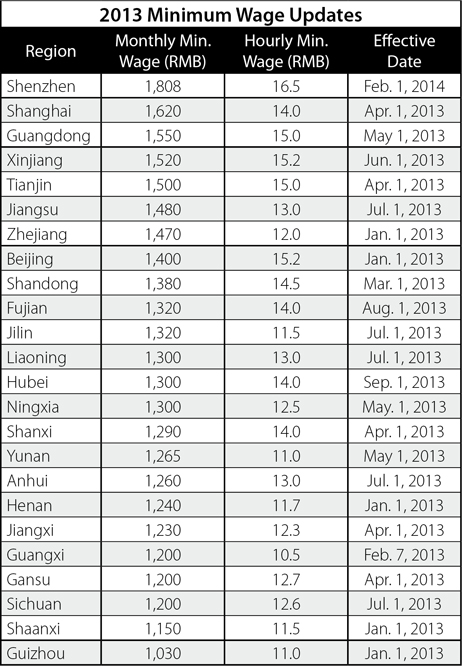Shenzhen to Hike Minimum Wage Levels
Dec. 30 – Shenzhen human resource officials announced last week that the city will raise its monthly minimum wage level by 13 percent to RMB1,808 from February 1, 2014, while its hourly minimum wage will be adjusted from RMB14.5 to RMB16.5.
The new minimum wage standards are expected to benefit about 936,000 workers in Shenzhen, according to the city’s human resources and social security bureau.
In China, local governments are required to raise their minimum wage levels at least once every two years as a matter of State policy. Shenzhen last updated its minimum wage levels in March 2013, raising the monthly minimum pay by RMB100 to RMB1,600.
In 2013, twenty-seven regions in China have adjusted their minimum wage levels including: Shenzhen, Shanghai, Guangdong, Xinjiang, Tianjin, Jiangsu, Zhejiang, Beijing, Shandong, Fujian, Jilin, Liaoning, Hubei, Ningxia, Shanxi, Yunan, Anhui, Henan, Jiangxi, Guangxi, Gansu, Sichuan, Shaanxi and Guizhou. Detailed information can be found in the chart below.

After the latest round of adjustments come into effect, Shenzhen will have the highest minimum wage in the country at RMB1,808, followed by Shanghai at RMB1,620. Shenzhen will also have the nation’s highest hourly wage rate at RMB16.5, followed by Beijing and Xinjiang at RMB 15.2.
The country’s Employment Promotion Plan provides that the minimum wage levels in China should grow by at least 13 percent annually through 2015, and the minimum wage levels in most areas should not be lower than 40 percent of the average local salary. Under such policies, minimum wage levels across the country have registered an average 12.6 percent annual growth rate from 2008-2012.
Dezan Shira & Associates is a specialist foreign direct investment practice, providing corporate establishment, business advisory, tax advisory and compliance, accounting, payroll, due diligence and financial review services to multinationals investing in emerging Asia. Since its establishment in 1992, the firm has grown into one of Asia’s most versatile full-service consultancies with operational offices across China, Hong Kong, India, Singapore and Vietnam as well as liaison offices in Italy and the United States.
For further details or to contact the firm, please email china@dezshira.com, visit www.dezshira.com, or download the company brochure.
You can stay up to date with the latest business and investment trends across Asia by subscribing to Asia Briefing’s complimentary update service featuring news, commentary, guides, and multimedia resources.
Related Reading
 Human Resources and Payroll in China (Third Edition)
Human Resources and Payroll in China (Third Edition)
A firm understanding of China’s laws and regulations related to human resources and payroll management is essential for foreign investors who want to establish or are already running foreign-invested entities in China. This guide aims to satisfy that information demand, while also serving as a valuable tool for local managers and HR professionals who may need to explain complex points of China’s labor policies in English.
 Social Insurance and Payroll
Social Insurance and Payroll
In this issue, we take a “back to basics” approach to China’s mandatory benefits. Where, exactly, is that extra 35-40 percent on top of an employee’s salary going? What are social insurance contribution rates, base amounts, and tax exemptions? How does all of this figure into the payroll process? We next look at mandatory benefits as a piece of the larger payroll puzzle, with highlights on two very China-specific pieces: FESCOs and hukou, China’s “domestic passport.”
Guangdong Revises Minimum Wage Levels
Shanghai Hikes Minimum Wage Levels, Takes Nation’s Top Spot from Shenzhen
A Complete Guide to China’s Minimum Wage Levels by Province, City, and District
Mandatory Social Welfare Benefits for Chinese Staff
China Initiates New Round of Minimum Wage Increases
Update: Foreigner Participation in China’s Social Insurance Scheme
- Previous Article China Seeks Comments on Revisions to Foreign Investment Laws
- Next Article China Considers Newly Proposed Free Trade Zones









